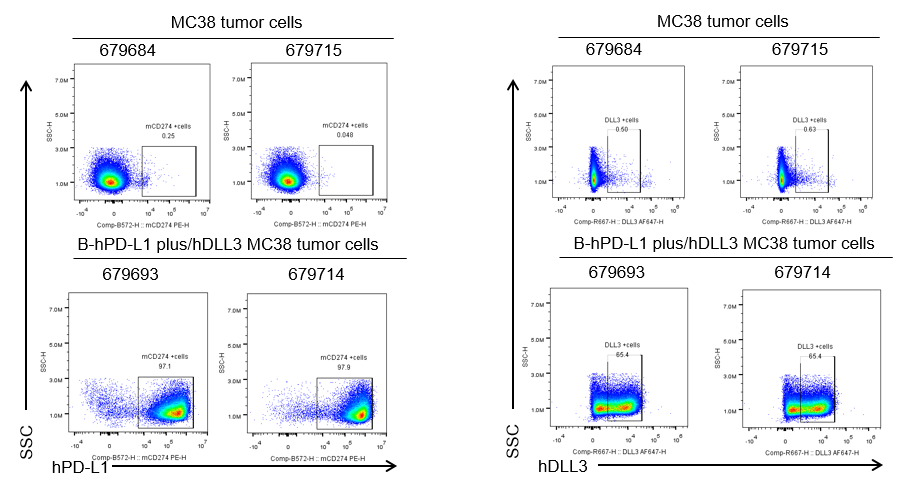
• 322420

| Product name | B-hPD-L1 plus/hDLL3 MC38 |
|---|---|
| Catalog number | 322420 |
| Strain background | C57BL/6 |
| NCBI gene ID | 29126,10683 (Human) |
| Chromosome | 19, 7 |
| Aliases | B7-H; B7H1; PDL1; PD-L1; ADMIO5; hPD-L1; PDCD1L1; PDCD1LG1; SCDO1 |
| Tissue | Colon |
| Disease | Colon carcinoma |

PD-L1 and DLL3 expression analysis in B-hPD-L1 plus/hDLL3 MC38 cells by flow cytometry. Single cell suspensions from B-hPD-L1 plus/hDLL3 MC38 #1-G10 were stained with species-specific anti-PD-L1 antibody (anti-mouse PD-L1: Biolegend, 124312; anti-human PD-L1: Biolegend, 329706) and anti-human DLL3 (AMG-757 analog, in-house). Human PD-L1 and DLL3 was detected on the surface of B-hPD-L1 plus/hDLL3 MC38 cells.

Subcutaneous tumor growth of B-hPD-L1 plus/hDLL3 MC38 cells. B-hPD-L1 plus/hDLL3 MC38 cells (5×105) and wild-type MC38 cells (5×105) were subcutaneously implanted into C57BL/6 mice (female, 7-week-old, n=6). Tumor volume and body weight were measured twice a week. (A) Average tumor volume. (B) Body weight. Volume was expressed in mm3 using the formula: V=0.5 × long diameter × short diameter2. Results indicate that B-hPD-L1 plus/hDLL3 MC38 cells were able to establish tumors in vivo and can be used for efficacy studies. Values are expressed as mean ± SEM.

PD-L1 and DLL3 expression were evaluated on B-hPD-L1 plus/hDLL3 MC38 tumor cells by flow cytometry. B-hPD-L1 plus/hDLL3 MC38 cells were subcutaneously transplanted into C57BL/6 mice. Upon conclusion of the experiment, tumor cells were harvested and assessed for human PD-L1 (Biolegend, 329714) and DLL3 (AMG-757 analog, in-house) expression by flow cytometry. As shown, human PD-L1 and DLL3 was highly expressed on the surface of tumor cells. Therefore, B-hPD-L1 plus/hDLL3 MC38 cells can be used for in vivo efficacy studies evaluating novel PD-L1 and DLL3 combination therapeutics.

Subcutaneous tumor growth of B-hPD-L1 plus/hDLL3 MC38 cells. B-hPD-L1 plus/hDLL3 MC38 cells (1×106) and wild-type MC38 cells (5×105) were subcutaneously implanted into C57BL/6 mice (female, 8-week-old, n=8). Tumor volume and body weight were measured twice a week. (A) Average tumor volume. (B) Body weight. Volume was expressed in mm3 using the formula: V=0.5 × long diameter × short diameter2. Results indicate that B-hPD-L1 plus/hDLL3 MC38 cells were able to establish tumors in vivo and can be used for efficacy studies. Values are expressed as mean ± SEM.